University Name: Diaspora, Displacement, and Identity in Literature
VerifiedAdded on 2023/06/01
|13
|3645
|207
Essay
AI Summary
This essay delves into the theme of diaspora as portrayed in contemporary literature, focusing on novels that depict the experiences of displacement and the search for identity. The analysis centers on works such as Dina Nayeri's "Refuge," Hala Alyan's "Salt House," Yusra Madini's "Butterfly," and Choman Hardy's "Life for Us." The essay examines how these authors use narrative techniques to convey the emotional and psychological impacts of being uprooted from one's homeland. It explores the challenges faced by characters in navigating new cultures, dealing with feelings of alienation, and maintaining connections to their heritage. Through close readings of these novels, the essay highlights the complexities of the refugee experience and the enduring human need for belonging, offering insights into the universal struggles of those affected by diaspora.
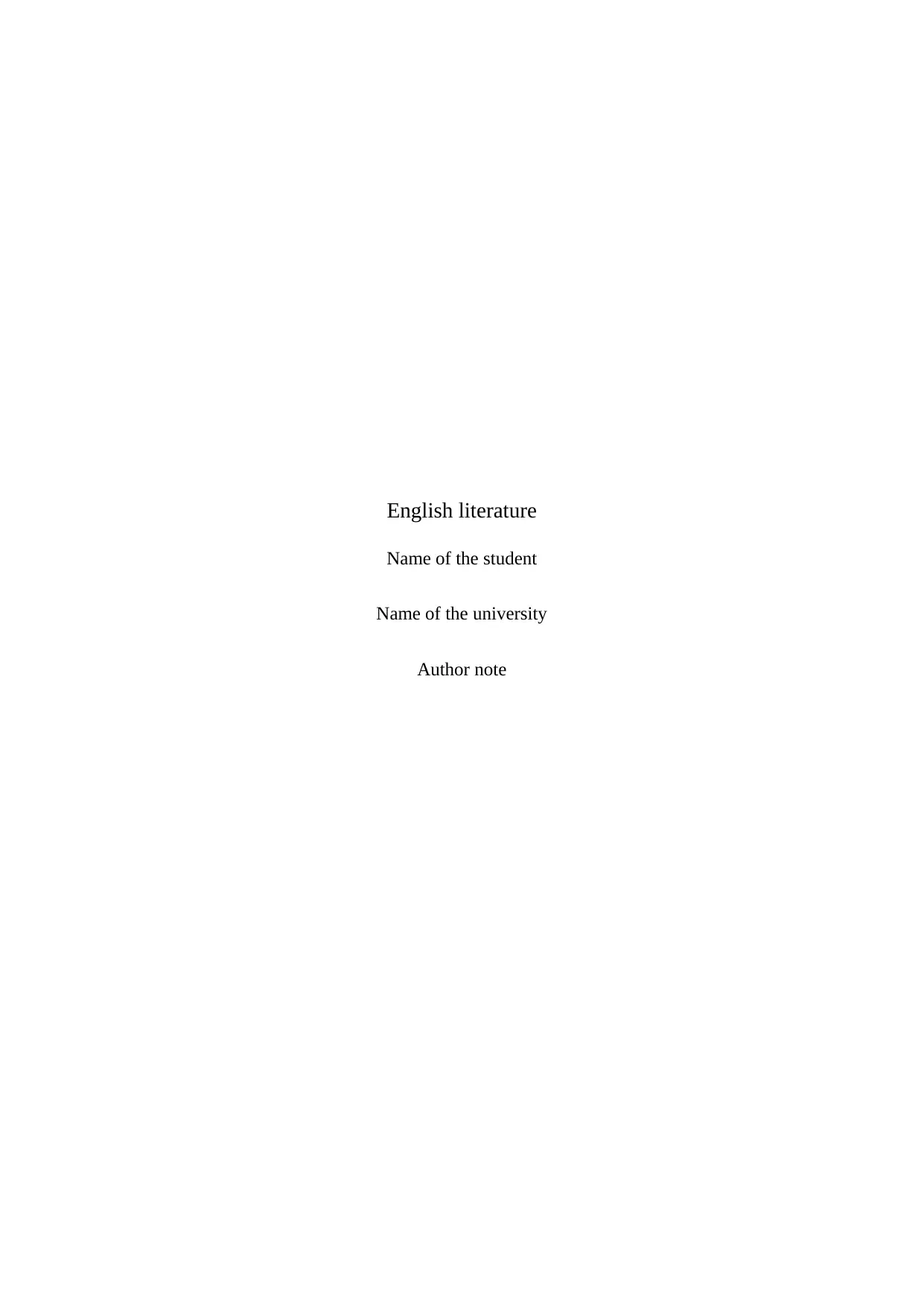
English literature
Name of the student
Name of the university
Author note
Name of the student
Name of the university
Author note
Paraphrase This Document
Need a fresh take? Get an instant paraphrase of this document with our AI Paraphraser
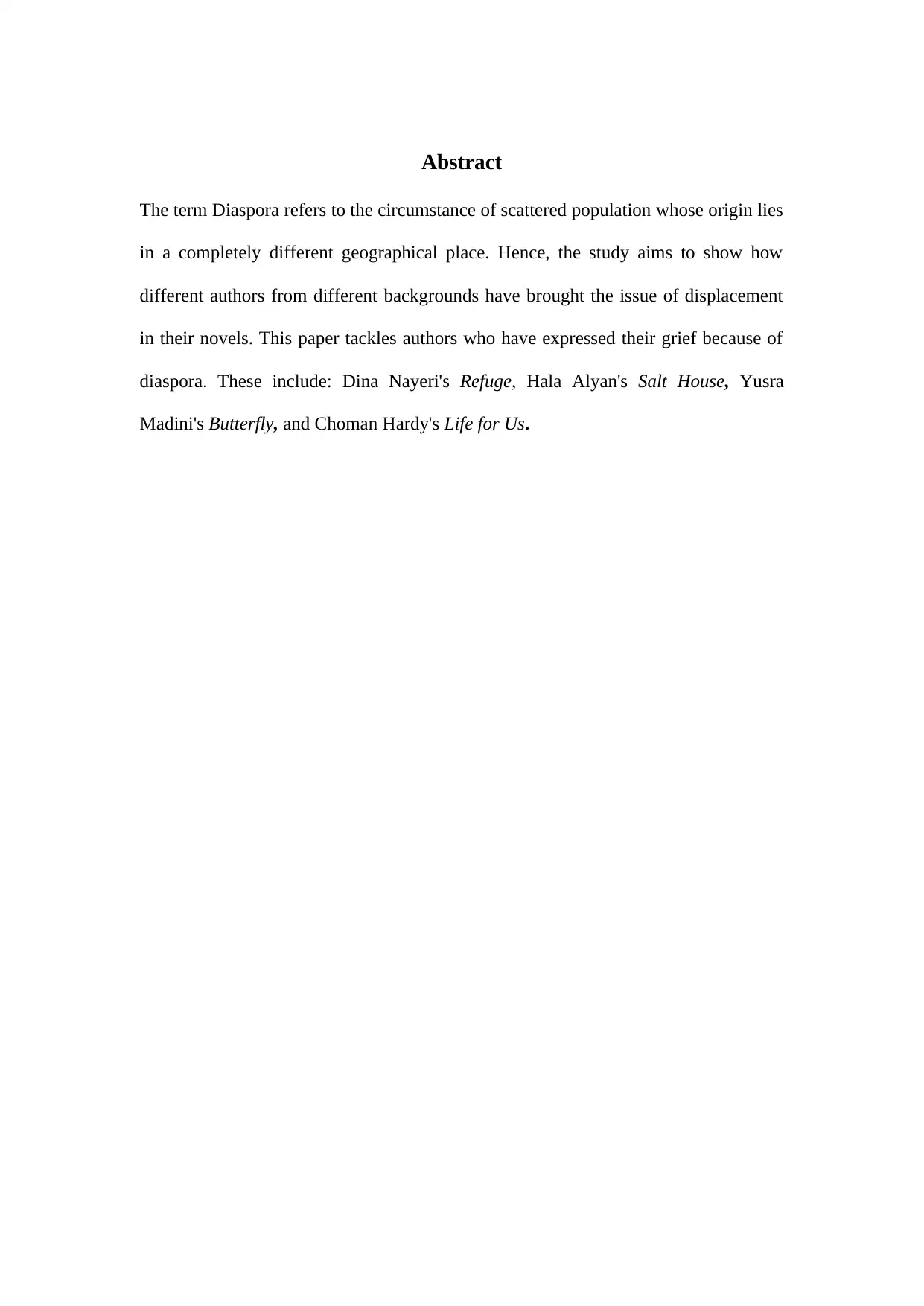
Abstract
The term Diaspora refers to the circumstance of scattered population whose origin lies
in a completely different geographical place. Hence, the study aims to show how
different authors from different backgrounds have brought the issue of displacement
in their novels. This paper tackles authors who have expressed their grief because of
diaspora. These include: Dina Nayeri's Refuge, Hala Alyan's Salt House, Yusra
Madini's Butterfly, and Choman Hardy's Life for Us.
The term Diaspora refers to the circumstance of scattered population whose origin lies
in a completely different geographical place. Hence, the study aims to show how
different authors from different backgrounds have brought the issue of displacement
in their novels. This paper tackles authors who have expressed their grief because of
diaspora. These include: Dina Nayeri's Refuge, Hala Alyan's Salt House, Yusra
Madini's Butterfly, and Choman Hardy's Life for Us.

Introduction
The novels like Salt House, Butterfly, Refuge, and Life for Us have depicted
the pain and sufferings of those in diaspora skillfully. For example, while Salt House,
written by the Palestinian-American writer Hala Alyan, portrays the turmoil and crisis
of the lives of Yacoub family, Refuge by Dina Nayeri effectively portrays the plight
of a child who was forced to leave her country leaving her father behind. On the other
hand, the two other books and Butterfly and Life for us are the predicament of the
human sufferings similarly.
Main Text
Refuge byDina Nayeri
Refuge by Dina Nayeri effectively portrays the plight of a child who was
forced to leave her country leaving her father behind. Through the novel, Nayeri
vividly describes the suffering of a child as she leaves her country (Schatzman &
Pamuk p.2). The theme of diaspora has been a very significant topic for many writers.
In her novel, Nayeri explores and scrutinizes the impacts of diaspora upon a child. In
addition to this, the novel efficiently portrays the intricacies of human relations along
with the uncertainties of human life.
As the story unfolds, the readers are being slowly acquainted with the
protagonist of the novel, Niloo. At a very young age, she is forced to leave her native
country, Iran. As she leaves her home with her mother and sister, her father stays
behind. Over the course of time, Niloo meets her father for a few times; however,
their relation does not bloom properly (Suleiman, 2016, p.4). Nayeri has portrayed the
character of Niloo as a trapped soul who claims, “Between East and West I lost
The novels like Salt House, Butterfly, Refuge, and Life for Us have depicted
the pain and sufferings of those in diaspora skillfully. For example, while Salt House,
written by the Palestinian-American writer Hala Alyan, portrays the turmoil and crisis
of the lives of Yacoub family, Refuge by Dina Nayeri effectively portrays the plight
of a child who was forced to leave her country leaving her father behind. On the other
hand, the two other books and Butterfly and Life for us are the predicament of the
human sufferings similarly.
Main Text
Refuge byDina Nayeri
Refuge by Dina Nayeri effectively portrays the plight of a child who was
forced to leave her country leaving her father behind. Through the novel, Nayeri
vividly describes the suffering of a child as she leaves her country (Schatzman &
Pamuk p.2). The theme of diaspora has been a very significant topic for many writers.
In her novel, Nayeri explores and scrutinizes the impacts of diaspora upon a child. In
addition to this, the novel efficiently portrays the intricacies of human relations along
with the uncertainties of human life.
As the story unfolds, the readers are being slowly acquainted with the
protagonist of the novel, Niloo. At a very young age, she is forced to leave her native
country, Iran. As she leaves her home with her mother and sister, her father stays
behind. Over the course of time, Niloo meets her father for a few times; however,
their relation does not bloom properly (Suleiman, 2016, p.4). Nayeri has portrayed the
character of Niloo as a trapped soul who claims, “Between East and West I lost
⊘ This is a preview!⊘
Do you want full access?
Subscribe today to unlock all pages.

Trusted by 1+ million students worldwide
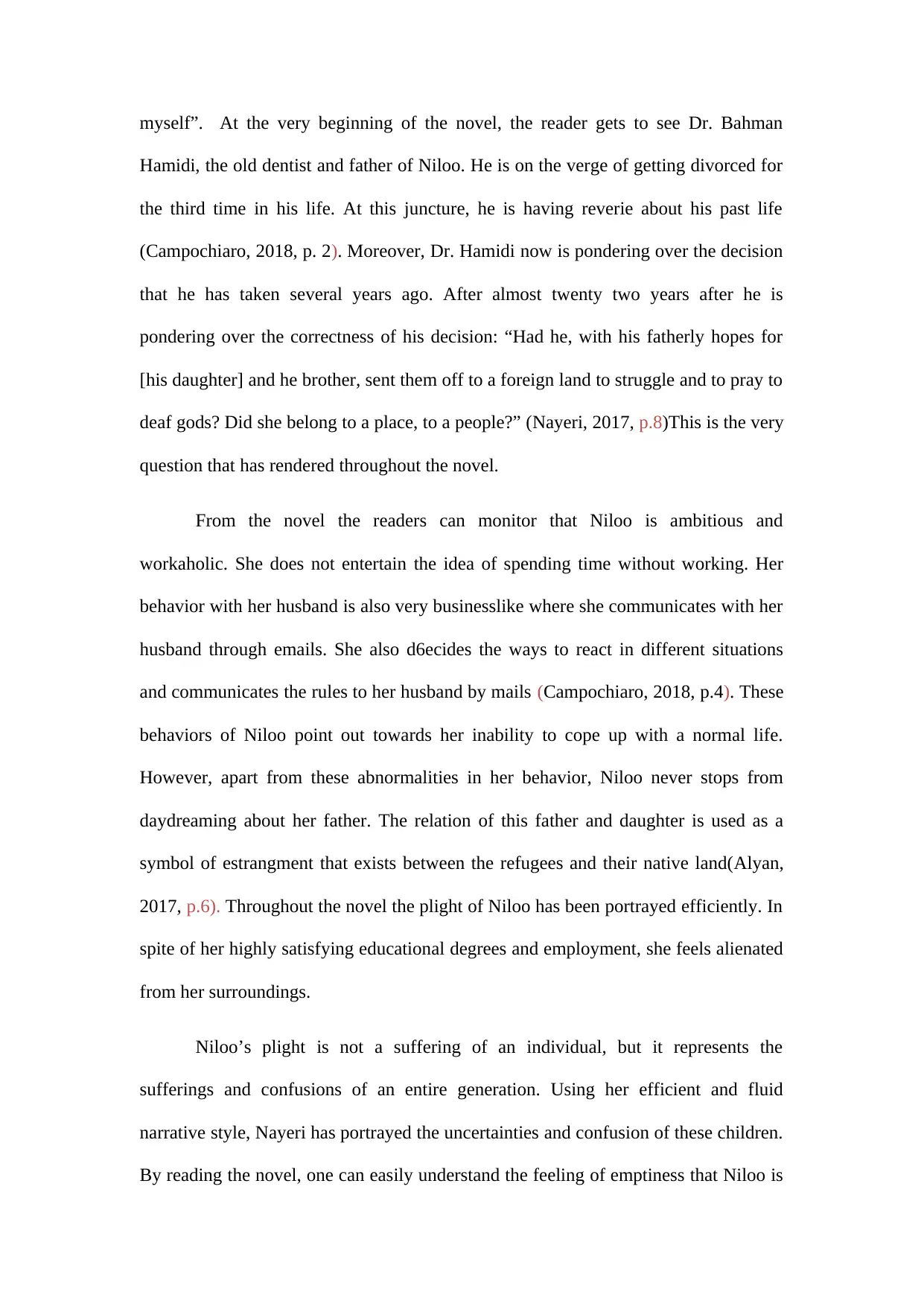
myself”. At the very beginning of the novel, the reader gets to see Dr. Bahman
Hamidi, the old dentist and father of Niloo. He is on the verge of getting divorced for
the third time in his life. At this juncture, he is having reverie about his past life
(Campochiaro, 2018, p. 2). Moreover, Dr. Hamidi now is pondering over the decision
that he has taken several years ago. After almost twenty two years after he is
pondering over the correctness of his decision: “Had he, with his fatherly hopes for
[his daughter] and he brother, sent them off to a foreign land to struggle and to pray to
deaf gods? Did she belong to a place, to a people?” (Nayeri, 2017, p.8)This is the very
question that has rendered throughout the novel.
From the novel the readers can monitor that Niloo is ambitious and
workaholic. She does not entertain the idea of spending time without working. Her
behavior with her husband is also very businesslike where she communicates with her
husband through emails. She also d6ecides the ways to react in different situations
and communicates the rules to her husband by mails (Campochiaro, 2018, p.4). These
behaviors of Niloo point out towards her inability to cope up with a normal life.
However, apart from these abnormalities in her behavior, Niloo never stops from
daydreaming about her father. The relation of this father and daughter is used as a
symbol of estrangment that exists between the refugees and their native land(Alyan,
2017, p.6). Throughout the novel the plight of Niloo has been portrayed efficiently. In
spite of her highly satisfying educational degrees and employment, she feels alienated
from her surroundings.
Niloo’s plight is not a suffering of an individual, but it represents the
sufferings and confusions of an entire generation. Using her efficient and fluid
narrative style, Nayeri has portrayed the uncertainties and confusion of these children.
By reading the novel, one can easily understand the feeling of emptiness that Niloo is
Hamidi, the old dentist and father of Niloo. He is on the verge of getting divorced for
the third time in his life. At this juncture, he is having reverie about his past life
(Campochiaro, 2018, p. 2). Moreover, Dr. Hamidi now is pondering over the decision
that he has taken several years ago. After almost twenty two years after he is
pondering over the correctness of his decision: “Had he, with his fatherly hopes for
[his daughter] and he brother, sent them off to a foreign land to struggle and to pray to
deaf gods? Did she belong to a place, to a people?” (Nayeri, 2017, p.8)This is the very
question that has rendered throughout the novel.
From the novel the readers can monitor that Niloo is ambitious and
workaholic. She does not entertain the idea of spending time without working. Her
behavior with her husband is also very businesslike where she communicates with her
husband through emails. She also d6ecides the ways to react in different situations
and communicates the rules to her husband by mails (Campochiaro, 2018, p.4). These
behaviors of Niloo point out towards her inability to cope up with a normal life.
However, apart from these abnormalities in her behavior, Niloo never stops from
daydreaming about her father. The relation of this father and daughter is used as a
symbol of estrangment that exists between the refugees and their native land(Alyan,
2017, p.6). Throughout the novel the plight of Niloo has been portrayed efficiently. In
spite of her highly satisfying educational degrees and employment, she feels alienated
from her surroundings.
Niloo’s plight is not a suffering of an individual, but it represents the
sufferings and confusions of an entire generation. Using her efficient and fluid
narrative style, Nayeri has portrayed the uncertainties and confusion of these children.
By reading the novel, one can easily understand the feeling of emptiness that Niloo is
Paraphrase This Document
Need a fresh take? Get an instant paraphrase of this document with our AI Paraphraser
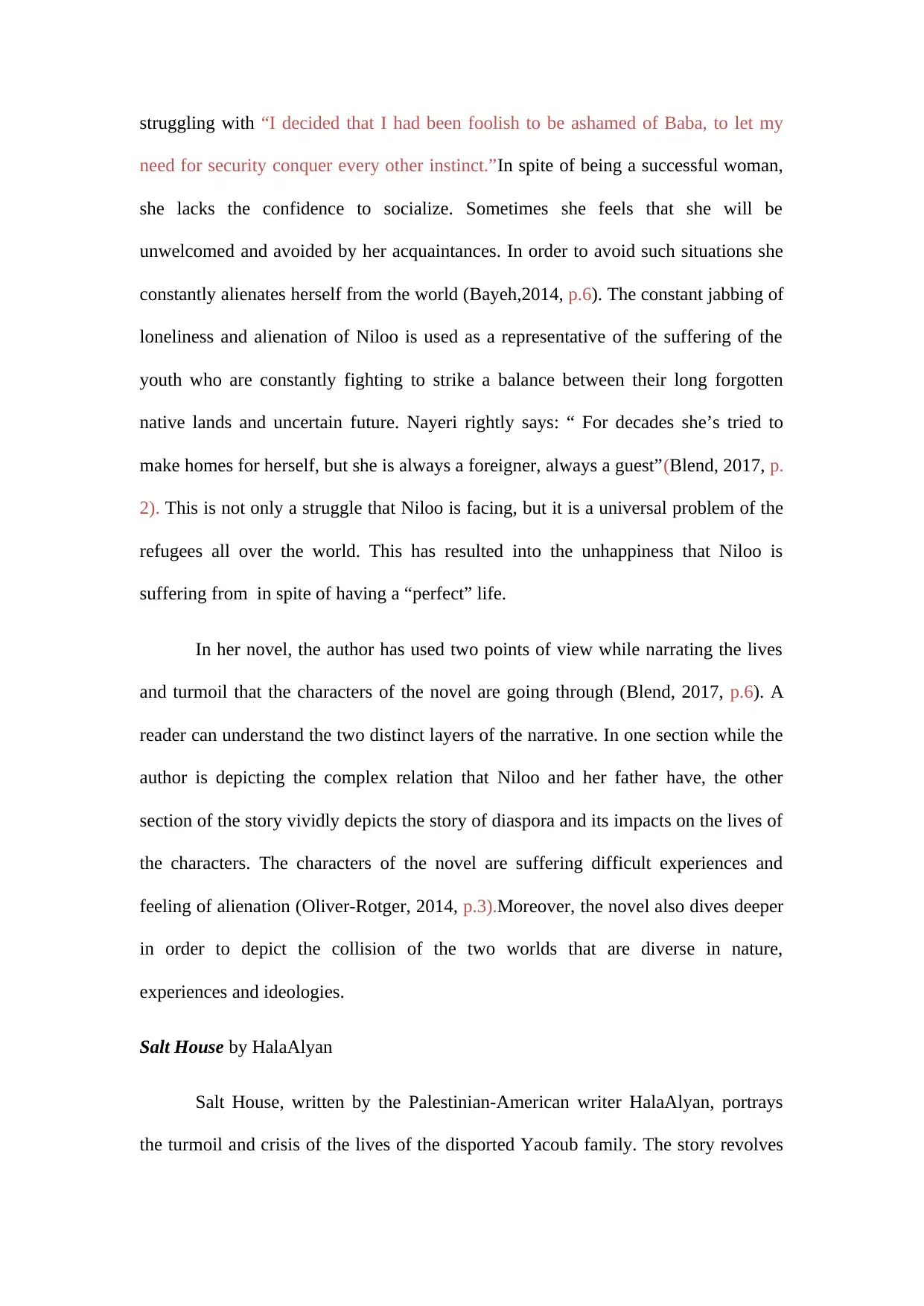
struggling with “I decided that I had been foolish to be ashamed of Baba, to let my
need for security conquer every other instinct.”In spite of being a successful woman,
she lacks the confidence to socialize. Sometimes she feels that she will be
unwelcomed and avoided by her acquaintances. In order to avoid such situations she
constantly alienates herself from the world (Bayeh,2014, p.6). The constant jabbing of
loneliness and alienation of Niloo is used as a representative of the suffering of the
youth who are constantly fighting to strike a balance between their long forgotten
native lands and uncertain future. Nayeri rightly says: “ For decades she’s tried to
make homes for herself, but she is always a foreigner, always a guest”(Blend, 2017, p.
2). This is not only a struggle that Niloo is facing, but it is a universal problem of the
refugees all over the world. This has resulted into the unhappiness that Niloo is
suffering from in spite of having a “perfect” life.
In her novel, the author has used two points of view while narrating the lives
and turmoil that the characters of the novel are going through (Blend, 2017, p.6). A
reader can understand the two distinct layers of the narrative. In one section while the
author is depicting the complex relation that Niloo and her father have, the other
section of the story vividly depicts the story of diaspora and its impacts on the lives of
the characters. The characters of the novel are suffering difficult experiences and
feeling of alienation (Oliver-Rotger, 2014, p.3).Moreover, the novel also dives deeper
in order to depict the collision of the two worlds that are diverse in nature,
experiences and ideologies.
Salt House by HalaAlyan
Salt House, written by the Palestinian-American writer HalaAlyan, portrays
the turmoil and crisis of the lives of the disported Yacoub family. The story revolves
need for security conquer every other instinct.”In spite of being a successful woman,
she lacks the confidence to socialize. Sometimes she feels that she will be
unwelcomed and avoided by her acquaintances. In order to avoid such situations she
constantly alienates herself from the world (Bayeh,2014, p.6). The constant jabbing of
loneliness and alienation of Niloo is used as a representative of the suffering of the
youth who are constantly fighting to strike a balance between their long forgotten
native lands and uncertain future. Nayeri rightly says: “ For decades she’s tried to
make homes for herself, but she is always a foreigner, always a guest”(Blend, 2017, p.
2). This is not only a struggle that Niloo is facing, but it is a universal problem of the
refugees all over the world. This has resulted into the unhappiness that Niloo is
suffering from in spite of having a “perfect” life.
In her novel, the author has used two points of view while narrating the lives
and turmoil that the characters of the novel are going through (Blend, 2017, p.6). A
reader can understand the two distinct layers of the narrative. In one section while the
author is depicting the complex relation that Niloo and her father have, the other
section of the story vividly depicts the story of diaspora and its impacts on the lives of
the characters. The characters of the novel are suffering difficult experiences and
feeling of alienation (Oliver-Rotger, 2014, p.3).Moreover, the novel also dives deeper
in order to depict the collision of the two worlds that are diverse in nature,
experiences and ideologies.
Salt House by HalaAlyan
Salt House, written by the Palestinian-American writer HalaAlyan, portrays
the turmoil and crisis of the lives of the disported Yacoub family. The story revolves
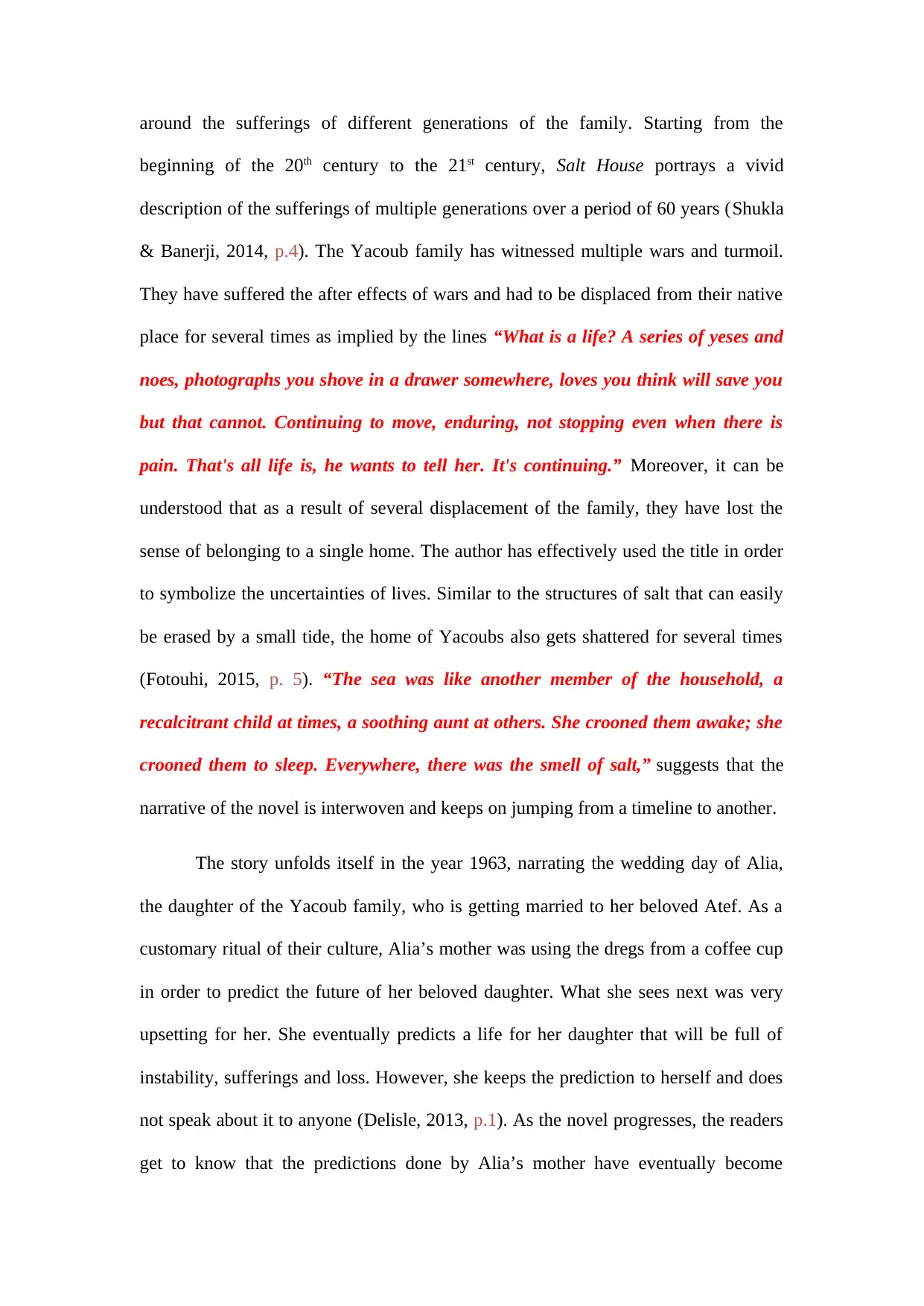
around the sufferings of different generations of the family. Starting from the
beginning of the 20th century to the 21st century, Salt House portrays a vivid
description of the sufferings of multiple generations over a period of 60 years (Shukla
& Banerji, 2014, p.4). The Yacoub family has witnessed multiple wars and turmoil.
They have suffered the after effects of wars and had to be displaced from their native
place for several times as implied by the lines “What is a life? A series of yeses and
noes, photographs you shove in a drawer somewhere, loves you think will save you
but that cannot. Continuing to move, enduring, not stopping even when there is
pain. That's all life is, he wants to tell her. It's continuing.” Moreover, it can be
understood that as a result of several displacement of the family, they have lost the
sense of belonging to a single home. The author has effectively used the title in order
to symbolize the uncertainties of lives. Similar to the structures of salt that can easily
be erased by a small tide, the home of Yacoubs also gets shattered for several times
(Fotouhi, 2015, p. 5). “The sea was like another member of the household, a
recalcitrant child at times, a soothing aunt at others. She crooned them awake; she
crooned them to sleep. Everywhere, there was the smell of salt,” suggests that the
narrative of the novel is interwoven and keeps on jumping from a timeline to another.
The story unfolds itself in the year 1963, narrating the wedding day of Alia,
the daughter of the Yacoub family, who is getting married to her beloved Atef. As a
customary ritual of their culture, Alia’s mother was using the dregs from a coffee cup
in order to predict the future of her beloved daughter. What she sees next was very
upsetting for her. She eventually predicts a life for her daughter that will be full of
instability, sufferings and loss. However, she keeps the prediction to herself and does
not speak about it to anyone (Delisle, 2013, p.1). As the novel progresses, the readers
get to know that the predictions done by Alia’s mother have eventually become
beginning of the 20th century to the 21st century, Salt House portrays a vivid
description of the sufferings of multiple generations over a period of 60 years (Shukla
& Banerji, 2014, p.4). The Yacoub family has witnessed multiple wars and turmoil.
They have suffered the after effects of wars and had to be displaced from their native
place for several times as implied by the lines “What is a life? A series of yeses and
noes, photographs you shove in a drawer somewhere, loves you think will save you
but that cannot. Continuing to move, enduring, not stopping even when there is
pain. That's all life is, he wants to tell her. It's continuing.” Moreover, it can be
understood that as a result of several displacement of the family, they have lost the
sense of belonging to a single home. The author has effectively used the title in order
to symbolize the uncertainties of lives. Similar to the structures of salt that can easily
be erased by a small tide, the home of Yacoubs also gets shattered for several times
(Fotouhi, 2015, p. 5). “The sea was like another member of the household, a
recalcitrant child at times, a soothing aunt at others. She crooned them awake; she
crooned them to sleep. Everywhere, there was the smell of salt,” suggests that the
narrative of the novel is interwoven and keeps on jumping from a timeline to another.
The story unfolds itself in the year 1963, narrating the wedding day of Alia,
the daughter of the Yacoub family, who is getting married to her beloved Atef. As a
customary ritual of their culture, Alia’s mother was using the dregs from a coffee cup
in order to predict the future of her beloved daughter. What she sees next was very
upsetting for her. She eventually predicts a life for her daughter that will be full of
instability, sufferings and loss. However, she keeps the prediction to herself and does
not speak about it to anyone (Delisle, 2013, p.1). As the novel progresses, the readers
get to know that the predictions done by Alia’s mother have eventually become
⊘ This is a preview!⊘
Do you want full access?
Subscribe today to unlock all pages.

Trusted by 1+ million students worldwide
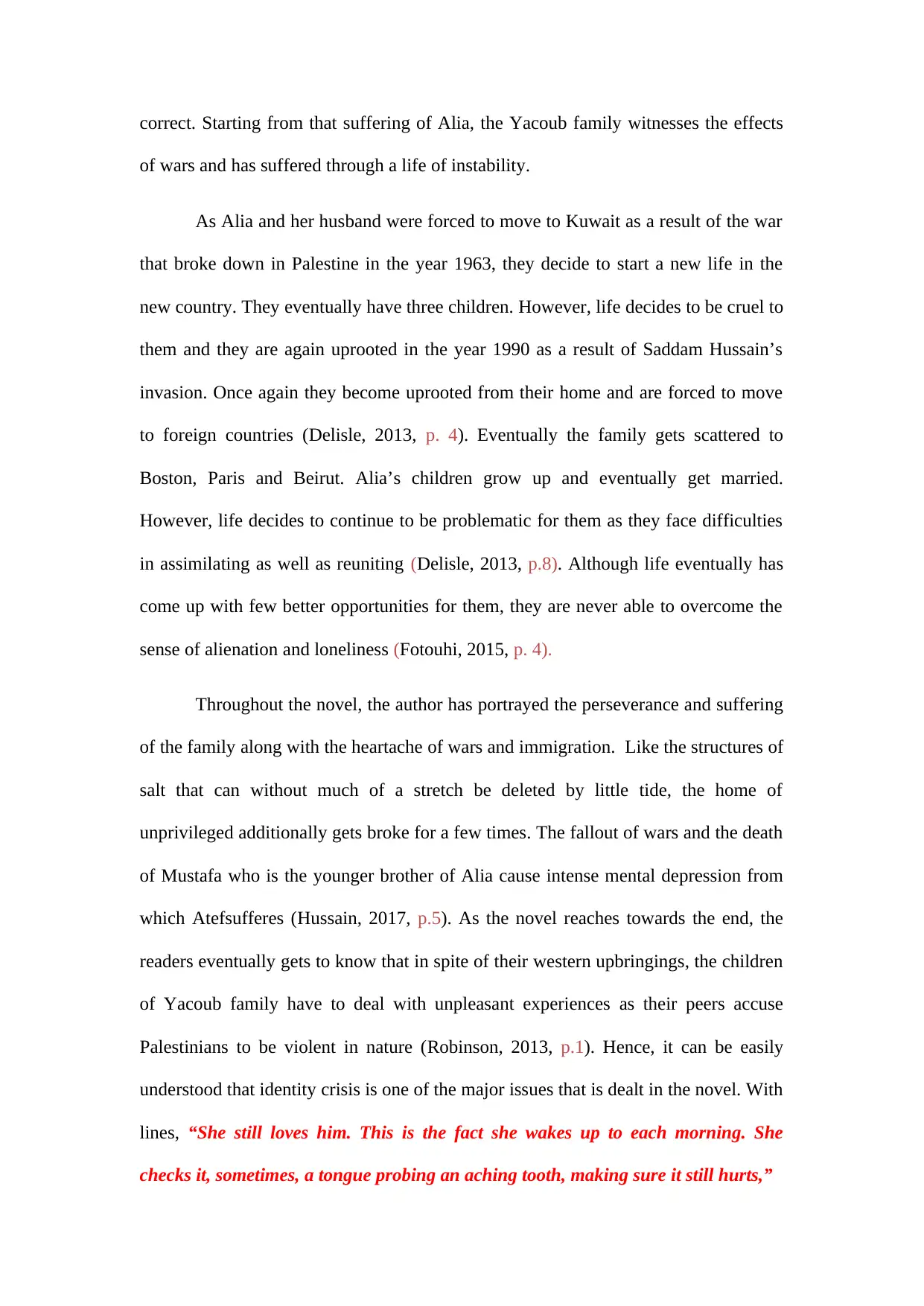
correct. Starting from that suffering of Alia, the Yacoub family witnesses the effects
of wars and has suffered through a life of instability.
As Alia and her husband were forced to move to Kuwait as a result of the war
that broke down in Palestine in the year 1963, they decide to start a new life in the
new country. They eventually have three children. However, life decides to be cruel to
them and they are again uprooted in the year 1990 as a result of Saddam Hussain’s
invasion. Once again they become uprooted from their home and are forced to move
to foreign countries (Delisle, 2013, p. 4). Eventually the family gets scattered to
Boston, Paris and Beirut. Alia’s children grow up and eventually get married.
However, life decides to continue to be problematic for them as they face difficulties
in assimilating as well as reuniting (Delisle, 2013, p.8). Although life eventually has
come up with few better opportunities for them, they are never able to overcome the
sense of alienation and loneliness (Fotouhi, 2015, p. 4).
Throughout the novel, the author has portrayed the perseverance and suffering
of the family along with the heartache of wars and immigration. Like the structures of
salt that can without much of a stretch be deleted by little tide, the home of
unprivileged additionally gets broke for a few times. The fallout of wars and the death
of Mustafa who is the younger brother of Alia cause intense mental depression from
which Atefsufferes (Hussain, 2017, p.5). As the novel reaches towards the end, the
readers eventually gets to know that in spite of their western upbringings, the children
of Yacoub family have to deal with unpleasant experiences as their peers accuse
Palestinians to be violent in nature (Robinson, 2013, p.1). Hence, it can be easily
understood that identity crisis is one of the major issues that is dealt in the novel. With
lines, “She still loves him. This is the fact she wakes up to each morning. She
checks it, sometimes, a tongue probing an aching tooth, making sure it still hurts,”
of wars and has suffered through a life of instability.
As Alia and her husband were forced to move to Kuwait as a result of the war
that broke down in Palestine in the year 1963, they decide to start a new life in the
new country. They eventually have three children. However, life decides to be cruel to
them and they are again uprooted in the year 1990 as a result of Saddam Hussain’s
invasion. Once again they become uprooted from their home and are forced to move
to foreign countries (Delisle, 2013, p. 4). Eventually the family gets scattered to
Boston, Paris and Beirut. Alia’s children grow up and eventually get married.
However, life decides to continue to be problematic for them as they face difficulties
in assimilating as well as reuniting (Delisle, 2013, p.8). Although life eventually has
come up with few better opportunities for them, they are never able to overcome the
sense of alienation and loneliness (Fotouhi, 2015, p. 4).
Throughout the novel, the author has portrayed the perseverance and suffering
of the family along with the heartache of wars and immigration. Like the structures of
salt that can without much of a stretch be deleted by little tide, the home of
unprivileged additionally gets broke for a few times. The fallout of wars and the death
of Mustafa who is the younger brother of Alia cause intense mental depression from
which Atefsufferes (Hussain, 2017, p.5). As the novel reaches towards the end, the
readers eventually gets to know that in spite of their western upbringings, the children
of Yacoub family have to deal with unpleasant experiences as their peers accuse
Palestinians to be violent in nature (Robinson, 2013, p.1). Hence, it can be easily
understood that identity crisis is one of the major issues that is dealt in the novel. With
lines, “She still loves him. This is the fact she wakes up to each morning. She
checks it, sometimes, a tongue probing an aching tooth, making sure it still hurts,”
Paraphrase This Document
Need a fresh take? Get an instant paraphrase of this document with our AI Paraphraser
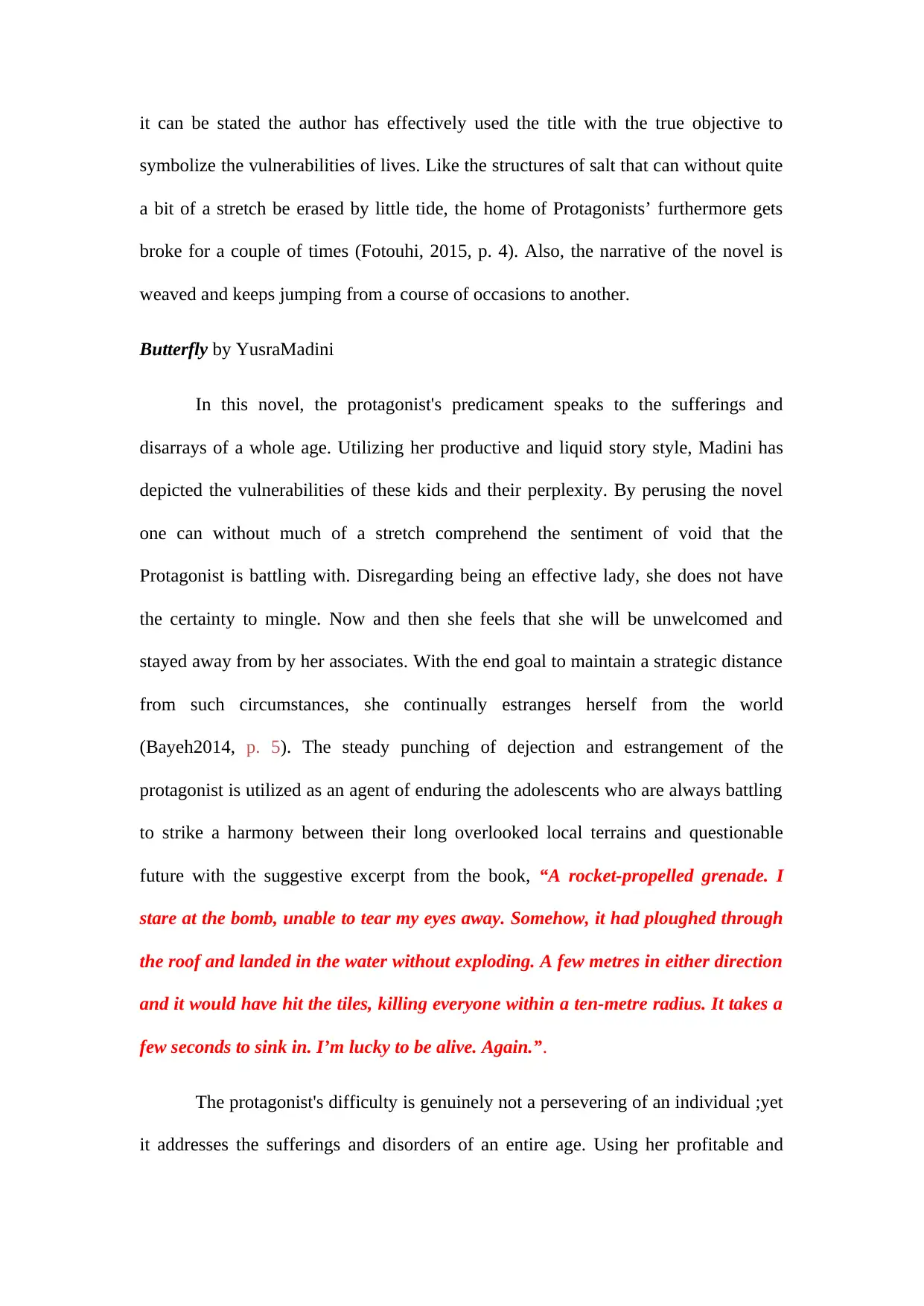
it can be stated the author has effectively used the title with the true objective to
symbolize the vulnerabilities of lives. Like the structures of salt that can without quite
a bit of a stretch be erased by little tide, the home of Protagonists’ furthermore gets
broke for a couple of times (Fotouhi, 2015, p. 4). Also, the narrative of the novel is
weaved and keeps jumping from a course of occasions to another.
Butterfly by YusraMadini
In this novel, the protagonist's predicament speaks to the sufferings and
disarrays of a whole age. Utilizing her productive and liquid story style, Madini has
depicted the vulnerabilities of these kids and their perplexity. By perusing the novel
one can without much of a stretch comprehend the sentiment of void that the
Protagonist is battling with. Disregarding being an effective lady, she does not have
the certainty to mingle. Now and then she feels that she will be unwelcomed and
stayed away from by her associates. With the end goal to maintain a strategic distance
from such circumstances, she continually estranges herself from the world
(Bayeh2014, p. 5). The steady punching of dejection and estrangement of the
protagonist is utilized as an agent of enduring the adolescents who are always battling
to strike a harmony between their long overlooked local terrains and questionable
future with the suggestive excerpt from the book, “A rocket-propelled grenade. I
stare at the bomb, unable to tear my eyes away. Somehow, it had ploughed through
the roof and landed in the water without exploding. A few metres in either direction
and it would have hit the tiles, killing everyone within a ten-metre radius. It takes a
few seconds to sink in. I’m lucky to be alive. Again.”.
The protagonist's difficulty is genuinely not a persevering of an individual ;yet
it addresses the sufferings and disorders of an entire age. Using her profitable and
symbolize the vulnerabilities of lives. Like the structures of salt that can without quite
a bit of a stretch be erased by little tide, the home of Protagonists’ furthermore gets
broke for a couple of times (Fotouhi, 2015, p. 4). Also, the narrative of the novel is
weaved and keeps jumping from a course of occasions to another.
Butterfly by YusraMadini
In this novel, the protagonist's predicament speaks to the sufferings and
disarrays of a whole age. Utilizing her productive and liquid story style, Madini has
depicted the vulnerabilities of these kids and their perplexity. By perusing the novel
one can without much of a stretch comprehend the sentiment of void that the
Protagonist is battling with. Disregarding being an effective lady, she does not have
the certainty to mingle. Now and then she feels that she will be unwelcomed and
stayed away from by her associates. With the end goal to maintain a strategic distance
from such circumstances, she continually estranges herself from the world
(Bayeh2014, p. 5). The steady punching of dejection and estrangement of the
protagonist is utilized as an agent of enduring the adolescents who are always battling
to strike a harmony between their long overlooked local terrains and questionable
future with the suggestive excerpt from the book, “A rocket-propelled grenade. I
stare at the bomb, unable to tear my eyes away. Somehow, it had ploughed through
the roof and landed in the water without exploding. A few metres in either direction
and it would have hit the tiles, killing everyone within a ten-metre radius. It takes a
few seconds to sink in. I’m lucky to be alive. Again.”.
The protagonist's difficulty is genuinely not a persevering of an individual ;yet
it addresses the sufferings and disorders of an entire age. Using her profitable and
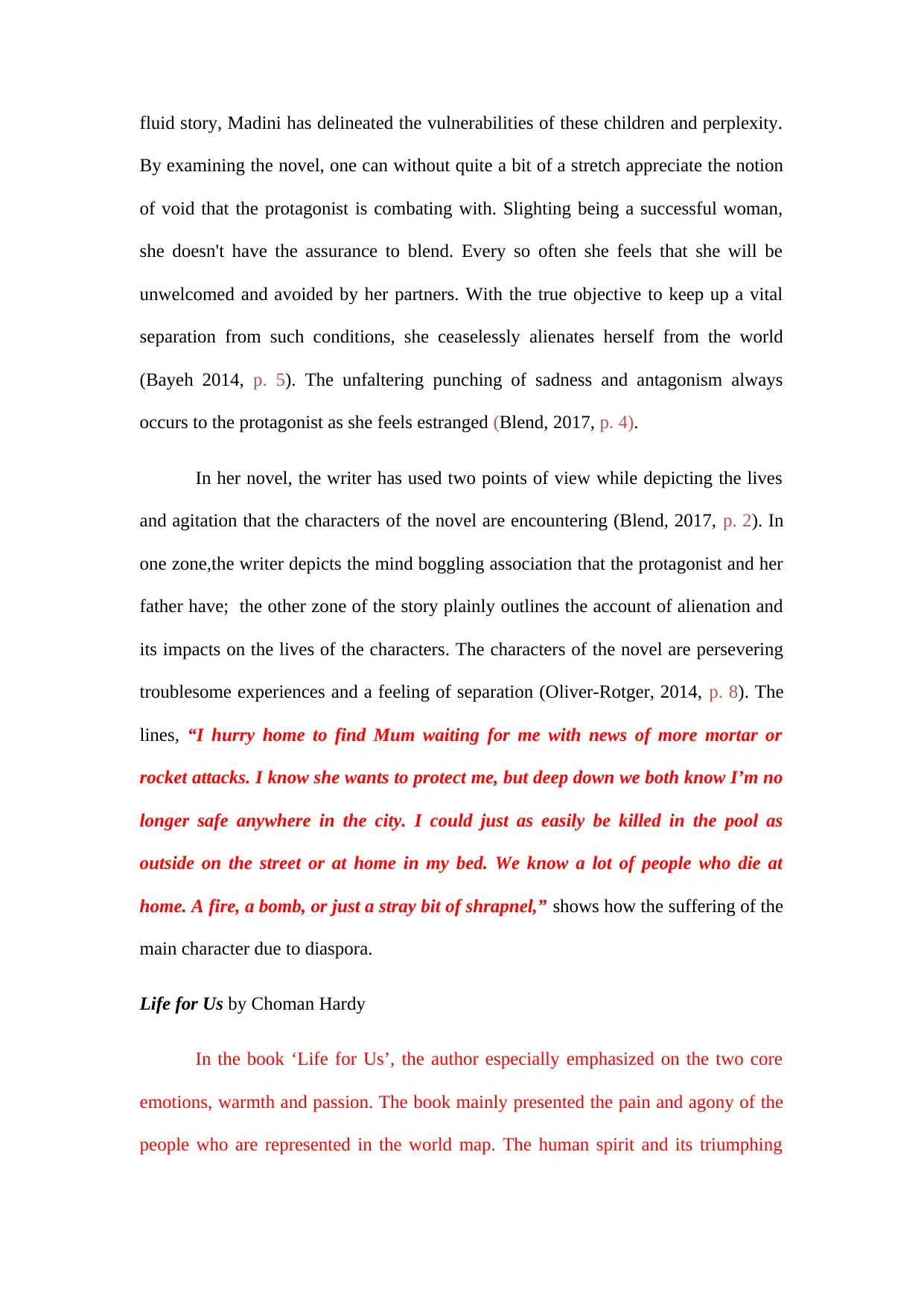
fluid story, Madini has delineated the vulnerabilities of these children and perplexity.
By examining the novel, one can without quite a bit of a stretch appreciate the notion
of void that the protagonist is combating with. Slighting being a successful woman,
she doesn't have the assurance to blend. Every so often she feels that she will be
unwelcomed and avoided by her partners. With the true objective to keep up a vital
separation from such conditions, she ceaselessly alienates herself from the world
(Bayeh 2014, p. 5). The unfaltering punching of sadness and antagonism always
occurs to the protagonist as she feels estranged (Blend, 2017, p. 4).
In her novel, the writer has used two points of view while depicting the lives
and agitation that the characters of the novel are encountering (Blend, 2017, p. 2). In
one zone,the writer depicts the mind boggling association that the protagonist and her
father have; the other zone of the story plainly outlines the account of alienation and
its impacts on the lives of the characters. The characters of the novel are persevering
troublesome experiences and a feeling of separation (Oliver-Rotger, 2014, p. 8). The
lines, “I hurry home to find Mum waiting for me with news of more mortar or
rocket attacks. I know she wants to protect me, but deep down we both know I’m no
longer safe anywhere in the city. I could just as easily be killed in the pool as
outside on the street or at home in my bed. We know a lot of people who die at
home. A fire, a bomb, or just a stray bit of shrapnel,” shows how the suffering of the
main character due to diaspora.
Life for Us by Choman Hardy
In the book ‘Life for Us’, the author especially emphasized on the two core
emotions, warmth and passion. The book mainly presented the pain and agony of the
people who are represented in the world map. The human spirit and its triumphing
By examining the novel, one can without quite a bit of a stretch appreciate the notion
of void that the protagonist is combating with. Slighting being a successful woman,
she doesn't have the assurance to blend. Every so often she feels that she will be
unwelcomed and avoided by her partners. With the true objective to keep up a vital
separation from such conditions, she ceaselessly alienates herself from the world
(Bayeh 2014, p. 5). The unfaltering punching of sadness and antagonism always
occurs to the protagonist as she feels estranged (Blend, 2017, p. 4).
In her novel, the writer has used two points of view while depicting the lives
and agitation that the characters of the novel are encountering (Blend, 2017, p. 2). In
one zone,the writer depicts the mind boggling association that the protagonist and her
father have; the other zone of the story plainly outlines the account of alienation and
its impacts on the lives of the characters. The characters of the novel are persevering
troublesome experiences and a feeling of separation (Oliver-Rotger, 2014, p. 8). The
lines, “I hurry home to find Mum waiting for me with news of more mortar or
rocket attacks. I know she wants to protect me, but deep down we both know I’m no
longer safe anywhere in the city. I could just as easily be killed in the pool as
outside on the street or at home in my bed. We know a lot of people who die at
home. A fire, a bomb, or just a stray bit of shrapnel,” shows how the suffering of the
main character due to diaspora.
Life for Us by Choman Hardy
In the book ‘Life for Us’, the author especially emphasized on the two core
emotions, warmth and passion. The book mainly presented the pain and agony of the
people who are represented in the world map. The human spirit and its triumphing
⊘ This is a preview!⊘
Do you want full access?
Subscribe today to unlock all pages.

Trusted by 1+ million students worldwide
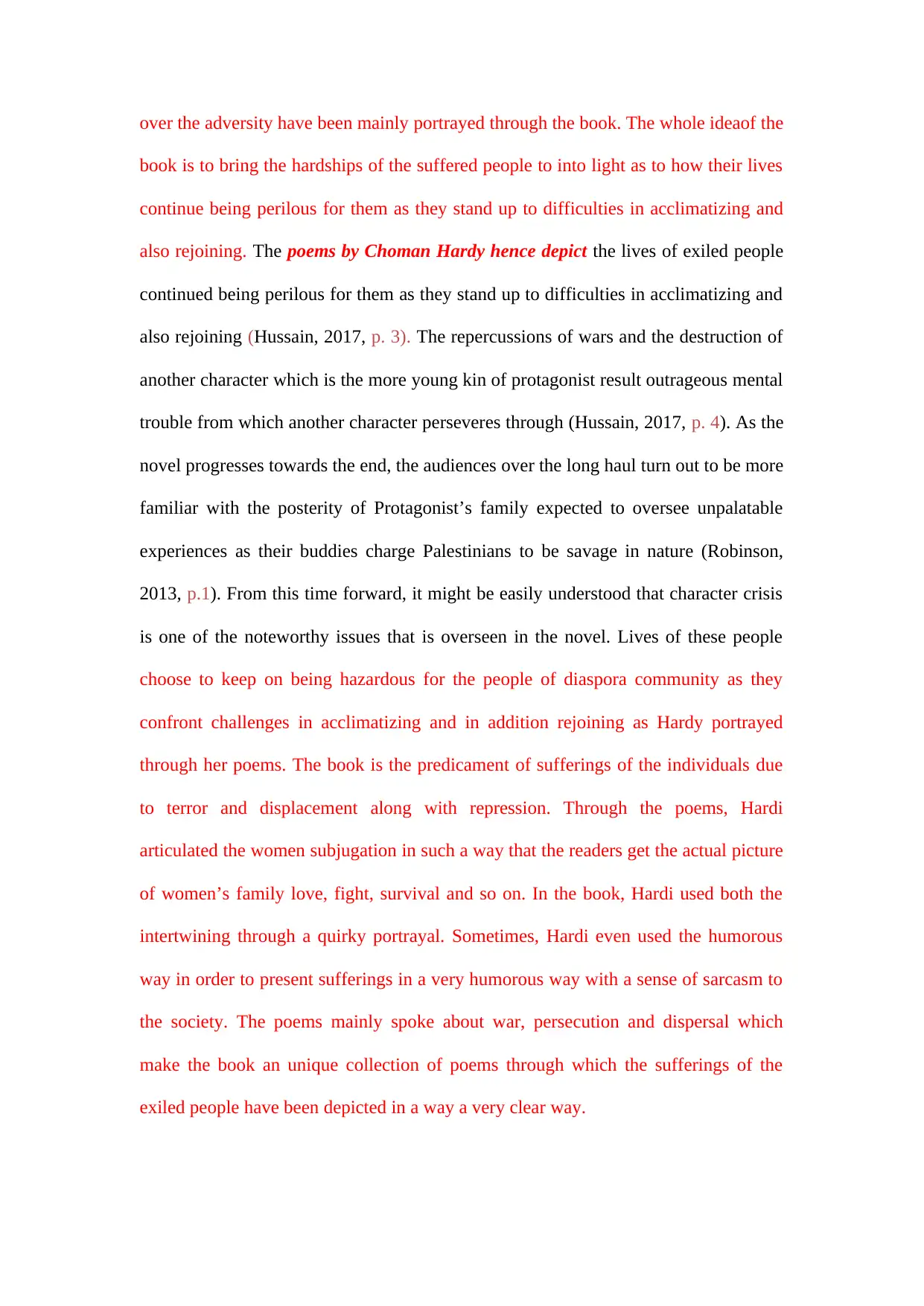
over the adversity have been mainly portrayed through the book. The whole ideaof the
book is to bring the hardships of the suffered people to into light as to how their lives
continue being perilous for them as they stand up to difficulties in acclimatizing and
also rejoining. The poems by Choman Hardy hence depict the lives of exiled people
continued being perilous for them as they stand up to difficulties in acclimatizing and
also rejoining (Hussain, 2017, p. 3). The repercussions of wars and the destruction of
another character which is the more young kin of protagonist result outrageous mental
trouble from which another character perseveres through (Hussain, 2017, p. 4). As the
novel progresses towards the end, the audiences over the long haul turn out to be more
familiar with the posterity of Protagonist’s family expected to oversee unpalatable
experiences as their buddies charge Palestinians to be savage in nature (Robinson,
2013, p.1). From this time forward, it might be easily understood that character crisis
is one of the noteworthy issues that is overseen in the novel. Lives of these people
choose to keep on being hazardous for the people of diaspora community as they
confront challenges in acclimatizing and in addition rejoining as Hardy portrayed
through her poems. The book is the predicament of sufferings of the individuals due
to terror and displacement along with repression. Through the poems, Hardi
articulated the women subjugation in such a way that the readers get the actual picture
of women’s family love, fight, survival and so on. In the book, Hardi used both the
intertwining through a quirky portrayal. Sometimes, Hardi even used the humorous
way in order to present sufferings in a very humorous way with a sense of sarcasm to
the society. The poems mainly spoke about war, persecution and dispersal which
make the book an unique collection of poems through which the sufferings of the
exiled people have been depicted in a way a very clear way.
book is to bring the hardships of the suffered people to into light as to how their lives
continue being perilous for them as they stand up to difficulties in acclimatizing and
also rejoining. The poems by Choman Hardy hence depict the lives of exiled people
continued being perilous for them as they stand up to difficulties in acclimatizing and
also rejoining (Hussain, 2017, p. 3). The repercussions of wars and the destruction of
another character which is the more young kin of protagonist result outrageous mental
trouble from which another character perseveres through (Hussain, 2017, p. 4). As the
novel progresses towards the end, the audiences over the long haul turn out to be more
familiar with the posterity of Protagonist’s family expected to oversee unpalatable
experiences as their buddies charge Palestinians to be savage in nature (Robinson,
2013, p.1). From this time forward, it might be easily understood that character crisis
is one of the noteworthy issues that is overseen in the novel. Lives of these people
choose to keep on being hazardous for the people of diaspora community as they
confront challenges in acclimatizing and in addition rejoining as Hardy portrayed
through her poems. The book is the predicament of sufferings of the individuals due
to terror and displacement along with repression. Through the poems, Hardi
articulated the women subjugation in such a way that the readers get the actual picture
of women’s family love, fight, survival and so on. In the book, Hardi used both the
intertwining through a quirky portrayal. Sometimes, Hardi even used the humorous
way in order to present sufferings in a very humorous way with a sense of sarcasm to
the society. The poems mainly spoke about war, persecution and dispersal which
make the book an unique collection of poems through which the sufferings of the
exiled people have been depicted in a way a very clear way.
Paraphrase This Document
Need a fresh take? Get an instant paraphrase of this document with our AI Paraphraser
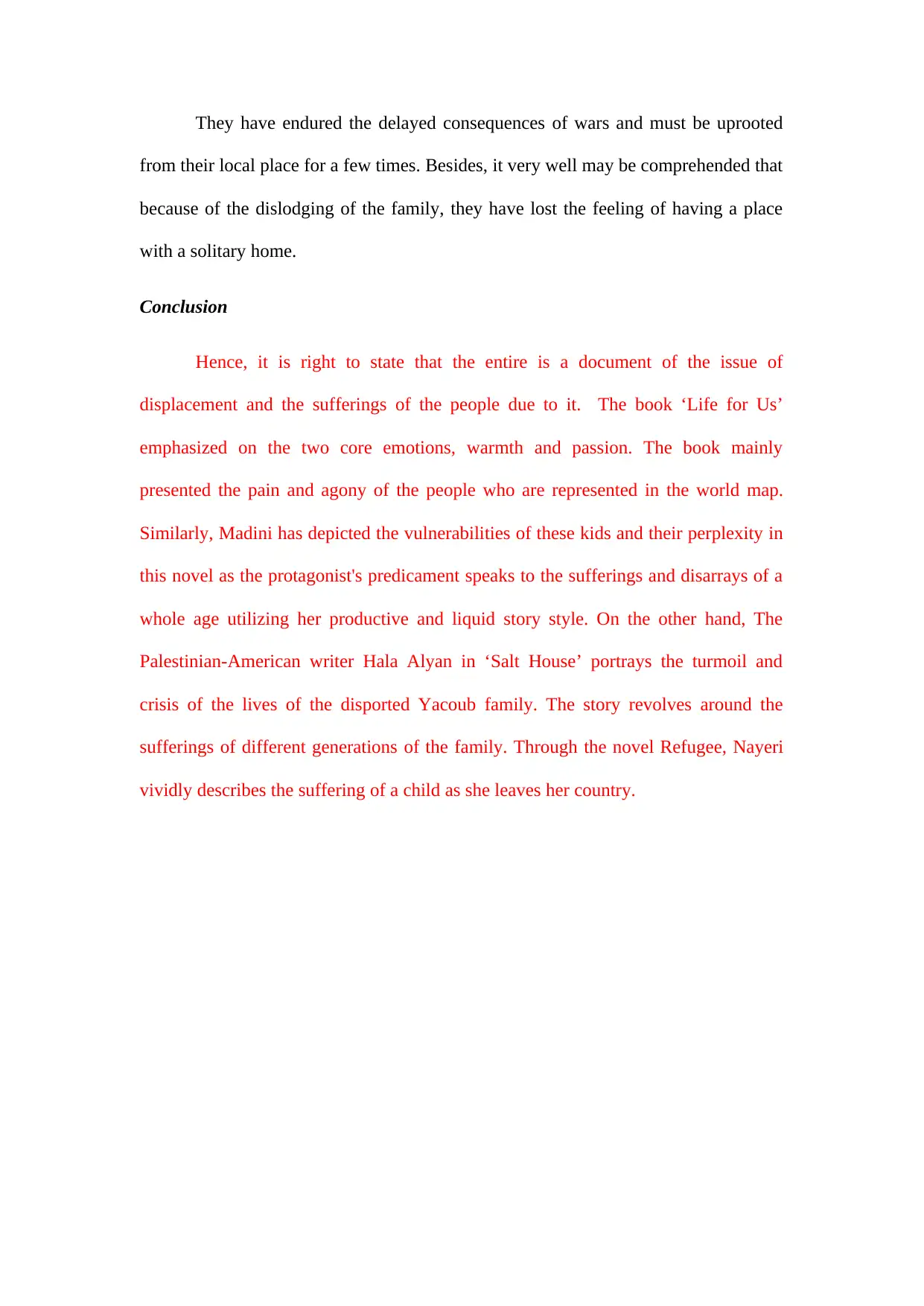
They have endured the delayed consequences of wars and must be uprooted
from their local place for a few times. Besides, it very well may be comprehended that
because of the dislodging of the family, they have lost the feeling of having a place
with a solitary home.
Conclusion
Hence, it is right to state that the entire is a document of the issue of
displacement and the sufferings of the people due to it. The book ‘Life for Us’
emphasized on the two core emotions, warmth and passion. The book mainly
presented the pain and agony of the people who are represented in the world map.
Similarly, Madini has depicted the vulnerabilities of these kids and their perplexity in
this novel as the protagonist's predicament speaks to the sufferings and disarrays of a
whole age utilizing her productive and liquid story style. On the other hand, The
Palestinian-American writer Hala Alyan in ‘Salt House’ portrays the turmoil and
crisis of the lives of the disported Yacoub family. The story revolves around the
sufferings of different generations of the family. Through the novel Refugee, Nayeri
vividly describes the suffering of a child as she leaves her country.
from their local place for a few times. Besides, it very well may be comprehended that
because of the dislodging of the family, they have lost the feeling of having a place
with a solitary home.
Conclusion
Hence, it is right to state that the entire is a document of the issue of
displacement and the sufferings of the people due to it. The book ‘Life for Us’
emphasized on the two core emotions, warmth and passion. The book mainly
presented the pain and agony of the people who are represented in the world map.
Similarly, Madini has depicted the vulnerabilities of these kids and their perplexity in
this novel as the protagonist's predicament speaks to the sufferings and disarrays of a
whole age utilizing her productive and liquid story style. On the other hand, The
Palestinian-American writer Hala Alyan in ‘Salt House’ portrays the turmoil and
crisis of the lives of the disported Yacoub family. The story revolves around the
sufferings of different generations of the family. Through the novel Refugee, Nayeri
vividly describes the suffering of a child as she leaves her country.
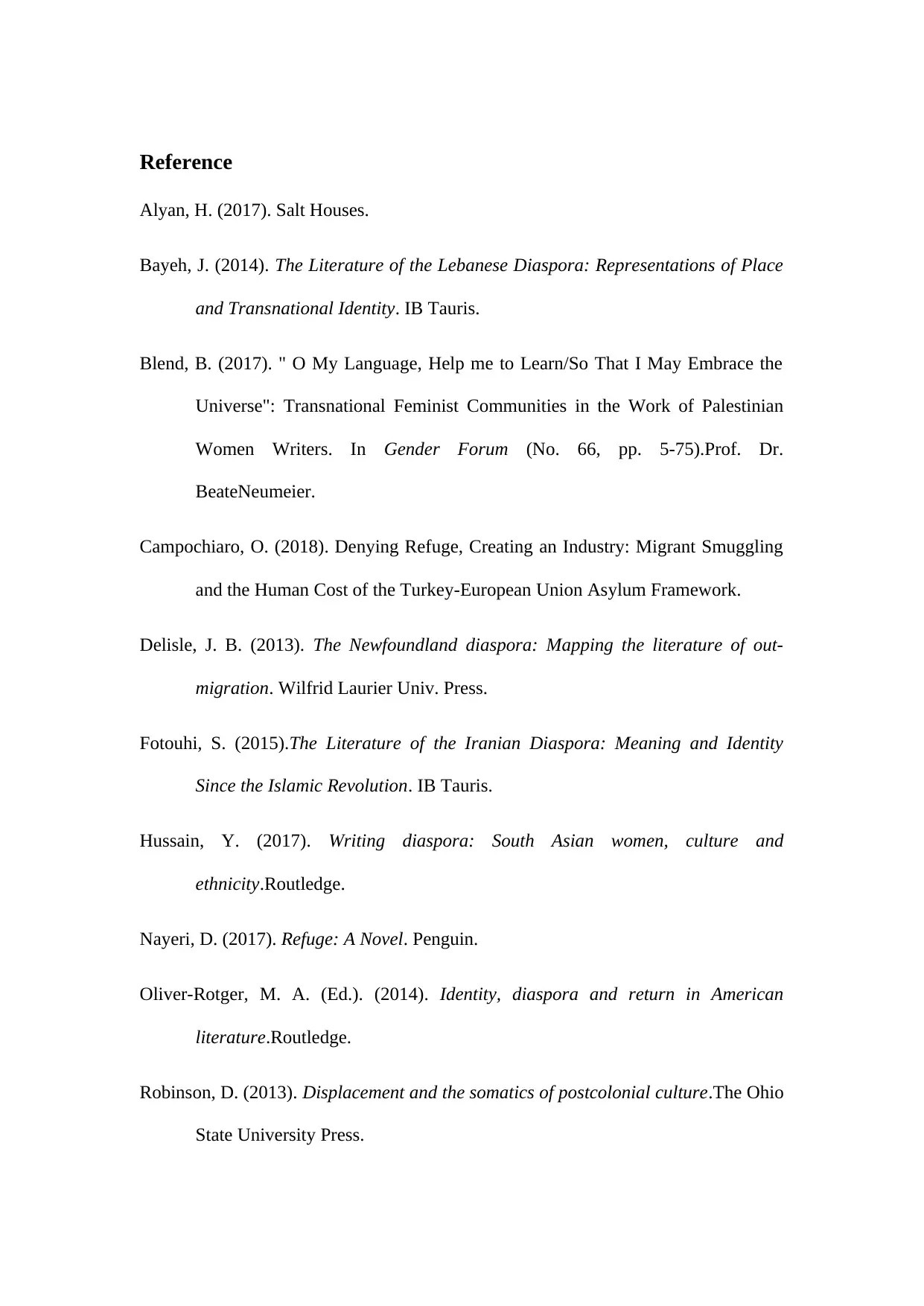
Reference
Alyan, H. (2017). Salt Houses.
Bayeh, J. (2014). The Literature of the Lebanese Diaspora: Representations of Place
and Transnational Identity. IB Tauris.
Blend, B. (2017). " O My Language, Help me to Learn/So That I May Embrace the
Universe": Transnational Feminist Communities in the Work of Palestinian
Women Writers. In Gender Forum (No. 66, pp. 5-75).Prof. Dr.
BeateNeumeier.
Campochiaro, O. (2018). Denying Refuge, Creating an Industry: Migrant Smuggling
and the Human Cost of the Turkey-European Union Asylum Framework.
Delisle, J. B. (2013). The Newfoundland diaspora: Mapping the literature of out-
migration. Wilfrid Laurier Univ. Press.
Fotouhi, S. (2015).The Literature of the Iranian Diaspora: Meaning and Identity
Since the Islamic Revolution. IB Tauris.
Hussain, Y. (2017). Writing diaspora: South Asian women, culture and
ethnicity.Routledge.
Nayeri, D. (2017). Refuge: A Novel. Penguin.
Oliver-Rotger, M. A. (Ed.). (2014). Identity, diaspora and return in American
literature.Routledge.
Robinson, D. (2013). Displacement and the somatics of postcolonial culture.The Ohio
State University Press.
Alyan, H. (2017). Salt Houses.
Bayeh, J. (2014). The Literature of the Lebanese Diaspora: Representations of Place
and Transnational Identity. IB Tauris.
Blend, B. (2017). " O My Language, Help me to Learn/So That I May Embrace the
Universe": Transnational Feminist Communities in the Work of Palestinian
Women Writers. In Gender Forum (No. 66, pp. 5-75).Prof. Dr.
BeateNeumeier.
Campochiaro, O. (2018). Denying Refuge, Creating an Industry: Migrant Smuggling
and the Human Cost of the Turkey-European Union Asylum Framework.
Delisle, J. B. (2013). The Newfoundland diaspora: Mapping the literature of out-
migration. Wilfrid Laurier Univ. Press.
Fotouhi, S. (2015).The Literature of the Iranian Diaspora: Meaning and Identity
Since the Islamic Revolution. IB Tauris.
Hussain, Y. (2017). Writing diaspora: South Asian women, culture and
ethnicity.Routledge.
Nayeri, D. (2017). Refuge: A Novel. Penguin.
Oliver-Rotger, M. A. (Ed.). (2014). Identity, diaspora and return in American
literature.Routledge.
Robinson, D. (2013). Displacement and the somatics of postcolonial culture.The Ohio
State University Press.
⊘ This is a preview!⊘
Do you want full access?
Subscribe today to unlock all pages.

Trusted by 1+ million students worldwide
1 out of 13
Your All-in-One AI-Powered Toolkit for Academic Success.
+13062052269
info@desklib.com
Available 24*7 on WhatsApp / Email
![[object Object]](/_next/static/media/star-bottom.7253800d.svg)
Unlock your academic potential
Copyright © 2020–2025 A2Z Services. All Rights Reserved. Developed and managed by ZUCOL.